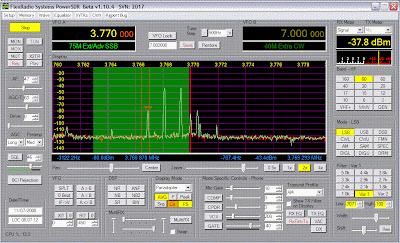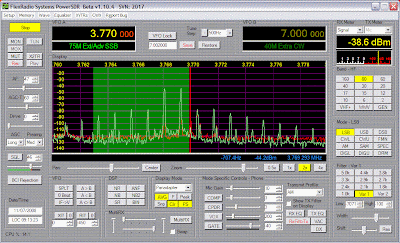Unfortunately, the effect of Transmitter IMD upon perceived voice quality is
poorly understood. So we're venturing off on our own into uncharted
territory... First, let's consider the effect of testing IMD at full power.
Makes sense, right? But suppose I told you that voice signals have a "crest
factor" of somewhere in the order of 9 dB? What does this mean?
Well, "Crest Factor" is the ratio of the peak level to the RMS level. A 9 dB
Crest Factor means that quite often our voices are at a level well below peak.
Which of course, raises the question, "What's the IMD of my transmitter when
my voice power is not at peak, but at, say, 9 dB below? (By the way, for a 100
watt transmitter, 9 dB below peak power of 100 watts would be 12.5
watts.)
Let's say IMD was measured only at peak power (in this example, 100 watts).
Now, suppose IMD in our particular transmitter
worsens as power is decreased from 100
watts. Given what we know of the crest factor of voice signals, an IMD
measurement made only at peak power will give a falsely positive indication of
how the transmitter sounds. So doesn't it make sense that IMD should be
measured not only at peak power, but at lower powers, too?
Personally, I recommend making IMD measurements at 4 different power levels:
Max power and then at powers that are 3, 6, and 9 dB below max power. For a
100 watt transmitter these four measurement points would be at: 100, 50, 25,
and 12.5 watts. I believe this will give a truer picture of how a transmitter
will sound in comparison to others.
Another problem with IMD measurements is that they're often stated solely in
terms of the 3rd-order product (that is, the product just to either side of
the two-tones used in the test, when viewed on a Spectrum Analyzer). In my
experience, defining transmitter quality with only the 3rd-order product of
IMD is not sufficient in determining how a transmitter will sound.
(You can enlarge either image by clicking on it.)
The first plot is my Flex 5000 at 0.1 watts. The second is the same
transmitter at 100 watts.
Note how, in both plots, the third-order products are essentially at the same
level relative to the two-tone test tones.
Yet, these two transmitters sound different.
The difference is subtle, yet it's there. And if you look at the images, it's
obvious why there's a difference: it's because, at 100 watts, the higher-order
distortion products are present, too.
















No comments:
Post a Comment